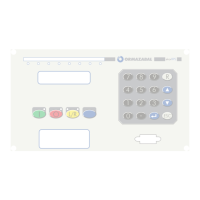IG-150-EN version 04; 03/10/16
45
General instructions
ekor.rps
Unit configuration
3. Unit configuration
The settings that are dened next congure the unit, for
what they are basic.
Some are only accessible by keyboard/display; others they
are also accessible by console.
All of them are of single table (table 0). By keyboard/display
you access the programming of the table 0 through the
menu “change settings” by means of the keys↑↑↓↓.
3.1. Programming of digital inputs and logic inputs
In the unit there are two dierent types of inputs: The
digital inputs (physical, wired in the eld) or logical inputs
(internal). Each function of possible input (for example
“breaker state”) is only programmed as digital or logical, but
never as both at the same time.
The programming of digital inputs is as follows:
By console, it is carried out on the screen “digital inputs
conguration”, in the upper square of the two located on
the right.
By keyboard/display:
PROG. TABLE 0 - PROG.CONFIGUR – CONFIG. INPUTS
SELECT. N0/NC
INPUTS ACTIV.T
Cong inputs allows programming a digital input among
the following possibilities:
1. Breaker status.
2. Reference voltage (for the recloser).
3. External protection (79/50 BF). It causes reclosure
(depending on the enables) and activates the breaker
failure function (three-phase).
4. Close command. It activates the closure relay.
5. Open command. Activates the general trip.
6. Instantaneous inhibition. If it is active, the overcurrent
instantaneous does not trip, but they count the time
passed since their picking up. So, when de input is
deactivated and the additional programmed time is
elapsed, they trip instantaneously.
7. Set table 1. If a pulse is received, sets settings table 1 as
the active table.
8. Set table 2. If a pulse is received, sets settings table 2 as
the active table.
9. Set table 3. If a pulse is received, sets settings table 3 as
the active table.
10. Set table 4. If a pulse is received, sets settings table 4 as
the active table.
11. Set table 5. If a pulse is received, sets settings table 5 as
the active table.
12. Set table 6. If a pulse is received, sets settings table 6 as
the active table.
13. Set local command/remote.
14. Close circuit supervision 1 with 52 open.
15. Close circuit supervision 1 with 52 close.
16. Trip circuit supervision 1 with 52 open.
17. Trip circuit supervision 1 with 52 close.
18. Close circuit supervision 2 with 52 open.
19. Close circuit supervision 2 with 52 close.
20. Trip circuit supervision 2 with 52 open.
21. Trip circuit supervision 2 with 52 close.
22. Local reposition. It turns o the tripping LEDs and
deactivates the relays programmed as “memorized”; it
is equal to fault recognition for keyboard/display.
23. df/dt breaker (level 1 to level 4). Option for 81 R function.
24. Teleprotection reception (for 85 function).
25. Guard signal loss (for 85 function).
26. Zone 3 address reverse (for 85 function).
27. 79/50BF. External protection A, B, C. They cause
reclosure (depending on the enables) and they activate
the respective breaker failure functions (single-phase).
28. Slack springs. For the corresponding automation.
29. Fuse failure. It activates the function with the same name.
30. Thermal image reposition. It resets the thermal image
temperature.
31. 67 NS Isen (φ) or Icos (φ). It allows using any algorithm,
regardless the setting in the neutral directional.
32. 67 NS Isen (φ) or Icos (φ). It allows using any algorithm,
regardless the setting in the sensitive neutral directional.
33. Close locking, it locks all the close commands, recloser,
push-button, command, and digital input.
34. Relay locking; while it is active, it sets the relay out of
service.
35. Recloser blocking. If it is active, the recloser is blocked
and it does not allow its unblocking by communications.
36. Not allocated. The input can be used by the protection
for lockout or logical, or not be used, anyway its state
can be transmitted to control.
It should not be programmed more than an input with a
certain function.

